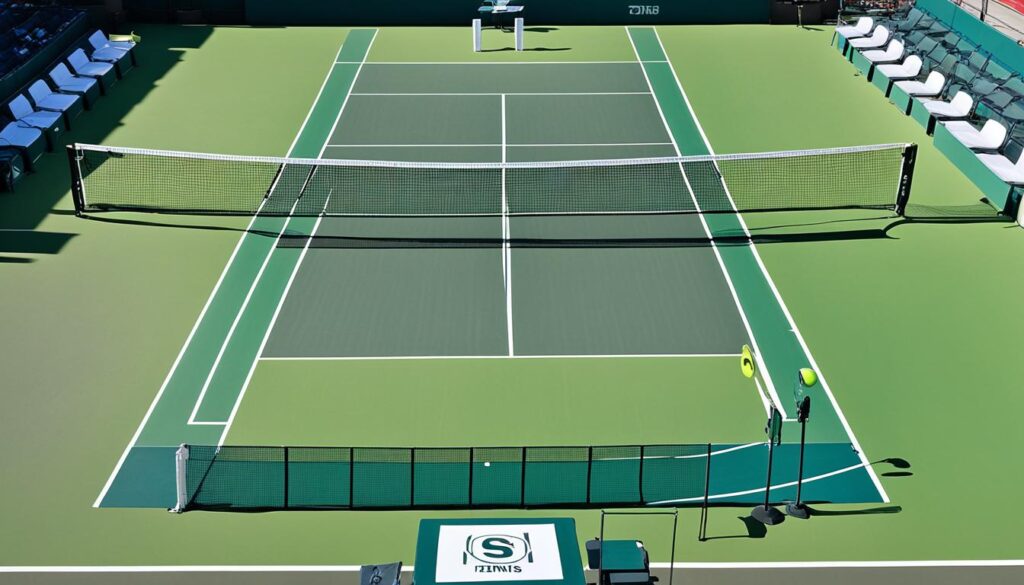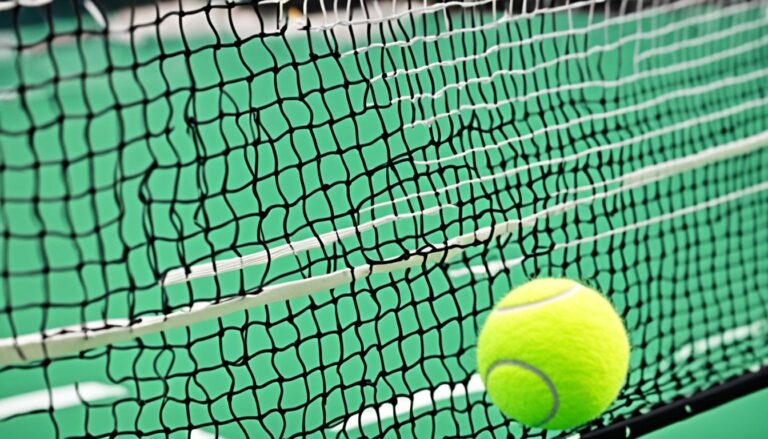When it comes to playing tennis, knowing and understanding the rules is essential. Whether you’re a beginner or looking to brush up on your skills, having a solid grasp of the tennis rules and regulations will ensure that you navigate the court with confidence and play the game correctly.
In this comprehensive guide, we will take you through the complete tennis rules, covering everything from the basic tennis rules to the official tennis rules that govern the game. Additionally, we will explore the tennis court rules and provide tips for beginner tennis players to get started.
By mastering these rules, not only will you enhance your playing abilities, but you’ll also ensure fair play and an enjoyable experience for everyone involved. So let’s dive in and unravel the fascinating world of tennis rules and regulations!
Understanding the Tennis Court Layout
The tennis court layout is a crucial aspect of the game, providing players with the boundaries and areas where they play their shots. By understanding the court layout, players can navigate the court effectively and make strategic decisions during matches.
The Significance of Service Boxes and Baselines
Two essential components of the tennis court layout are the service boxes and baselines. The service boxes are located on either side of the net and are where players must serve the ball from. These boxes determine the angle and direction of the serve, allowing players to strategically position themselves for the return.
The baselines, on the other hand, mark the ends of the court and determine the length of the court. Players must stay behind the baselines when hitting shots from the baseline area, ensuring fair play and adherence to the rules. Understanding the positioning and significance of the service boxes and baselines is essential for players to control the flow of the game.
Tiebreaker Procedures: Navigating the 13th Game
In tennis, tiebreakers are used to determine the winner of a set when the score reaches a six-game all tie. This occurs when both players or teams have won six games each. In a tiebreaker, the scoring system changes, and the game is played to a set number of points.
Understanding tiebreaker rules is crucial for navigating the 13th game of a set. Instead of the typical game scoring (love, 15, 30, 40), tiebreakers use a point system. The first player or team to reach seven points with a two-point lead wins the tiebreaker and the set. This aspect of the game introduces a unique dynamic and requires players to adapt their strategies to secure victory during tiebreakers.

Tennis Scoring Lingo Explained
Tennis has its own unique scoring system that can be confusing for beginners. To fully enjoy and participate in a tennis match, it’s important to understand the scoring lingo used in the game. Let’s break down the key terms and concepts that make up the tennis point system.
1. Points: In tennis, points are awarded after each rally. The first point won is called “15,” the second point is “30,” and the third point is “40.” If both players are tied at 40 points, it’s referred to as “deuce.”
2. Games: A game is the unit of scoring in tennis. To win a game, a player must win four points. However, there is a specific scoring progression to follow. If both players are tied at deuce, the game enters a “advantage” phase. The player who wins the next point after deuce gets “advantage,” and if they win the subsequent point as well, they win the game.
3. Sets: A set consists of a collection of games. To win a set, a player must win at least six games and have a two-game lead over their opponent. If a set reaches a 6-6 tie, a tiebreaker game is played to determine the winner.
4. Matches: A match is the overall contest between two players, consisting of the best of three or five sets. The first player to win the required number of sets wins the match.
By familiarizing yourself with these terms and concepts, you’ll be able to keep track of the score and follow the flow of a tennis match more effectively. Let’s now explore further tennis rules and regulations to deepen our understanding of the game.
Tennis Rules and Regulations: Serving and Receiving

Serving and receiving are fundamental aspects of tennis, and it’s essential for players to understand and follow the specific rules and regulations associated with these skills. By adhering to these rules, players can ensure fair play and an enjoyable tennis experience for everyone involved.
Executing a Legal Serve
Executing a legal serve involves several factors that players must consider. One important aspect is avoiding foot faults, which occur when a player steps over the baseline or touches the court with both feet during the serve. Foot faults result in the serve being considered illegal.
Additionally, players must aim to hit the correct areas of the service box when serving. The service box is divided into four quadrants, and the server must hit the ball into the diagonally opposite quadrant from where they are serving. Failing to hit the correct area will result in a fault.
It’s also important to note that players are allowed two attempts to execute a legal serve. If both attempts result in faults, it’s considered a double fault, resulting in the opponent gaining a point.
The Role of the Net and Netposts in Play
The net and netposts have a crucial role in the game of tennis. The net acts as a barrier that the ball must clear during play. If the ball hits the net and lands within the boundaries of the court, it’s considered a let, and the server gets another opportunity to serve without any penalties. However, if the ball hits the net and fails to clear it or lands outside the court, it’s considered a fault.
Netposts are the vertical posts positioned at the edges of the net, securing it in place. They must be positioned at a specific distance from the sidelines, ensuring the correct width for the playing area. If the netposts are not properly aligned, it can affect the height and tension of the net, resulting in an unfair playing surface.
Understanding the rules for serving and receiving, as well as the role of the net and netposts, is vital for players to participate in the game correctly. By following these rules, players can ensure fair competition and a level playing field for all.
Official Tennis Rules: Game Set Match

Official tennis rules provide a comprehensive guide to the game, covering all aspects from scoring to fouls. By familiarizing yourself with these rules, you’ll be able to participate in matches with confidence and legitimacy.
Let’s explore the specific rules for games, sets, and matches to ensure clarity on the requirements for winning each facet of play:
- Tennis Game Rules: In tennis, a game consists of points. The scoring system follows a sequence of 0, 15, 30, 40, and game point. To win a game, a player must reach game point and then win the following point.
- Tennis Set Rules: A set is a collection of games. To win a set, a player must win a minimum of six games and have a two-game advantage over their opponent. If the set reaches a 6-6 tie, a tiebreaker game is played to determine the winner.
- Tennis Match Rules: A match is typically the best of three or five sets, depending on the level of play or tournament format. The player who wins the majority of sets is declared the winner of the match.
By understanding these rules, you’ll be able to navigate the game of tennis with confidence, knowing the requirements for victory at each stage. Now let’s take a look at a visual representation of these rules:
| Tennis Game Rules | Tennis Set Rules | Tennis Match Rules |
|---|---|---|
| A player must win four points to win a game. | A player must win a minimum of six games and have a two-game advantage to win a set. | A player must win the majority of sets to win a match. |
| Score progression: 0, 15, 30, 40, game point | If the set reaches a 6-6 tie, a tiebreaker game is played. | Best of three/five sets determines match winner. |
Now that you have a clear understanding of the official tennis rules for games, sets, and matches, you’ll be able to confidently participate in the sport and enjoy the competition. Stay tuned for the next section where we’ll explore playing strategies against different styles of opponents.
Comprehensive Guide to Tennis Match Rules
A comprehensive understanding of tennis match rules is necessary for competitive play. By knowing the intricacies of the game, players can strategize and adapt their gameplay to different opponents and maximize their performance on the court.
Playing Against Different Styles of Opponents
When facing different opponents in tennis, it’s important to recognize their playing style and adjust your game accordingly. Here are some strategies to consider:
- Aggressive baseliners: If your opponent is known for a powerful baseline game, try to mix up your shots, vary the pace, and use drop shots or slices to disrupt their rhythm.
- Net rushers: Against opponents who frequently come to the net, try to hit deep shots to force them back and prevent them from approaching. Focus on hitting passing shots and lobs to exploit their position.
- Defensive players: When playing against defensive players, be patient and focus on consistency. Look for opportunities to attack and hit winners when they provide openings.
By adjusting your strategy to match your opponent’s style, you can exploit their weaknesses and gain an advantage in the match.
Strategic Use of Tennis Court Rules in Match Play
In addition to understanding your opponents’ styles, it’s essential to strategically use the tennis court rules to your advantage:
- Serving placement: Take advantage of the service box by placing your serves wide, forcing your opponent to hit from a disadvantageous position.
- Angle shots: Utilize the angles of the court to create openings and make it difficult for your opponent to reach the ball.
- Net clearance: When approaching the net, aim for shots with enough height to clear the net but still remain low enough to make it challenging for your opponent to hit effective passing shots.
- Footwork: Efficient footwork allows you to position yourself optimally on the court and reach difficult shots. Work on your movement to cover the court effectively and put constant pressure on your opponent.
By understanding and strategically utilizing the rules of the tennis court, you can enhance your gameplay and gain an edge in match play.
Conclusion
Mastering the rules of tennis is essential for all players, whether they’re beginners or seasoned athletes. Throughout this comprehensive guide, we have provided an overview of the essential tennis rules, ensuring that you have a solid foundation to navigate the court with confidence. By applying this knowledge and practicing with a solid understanding of the rules, you’ll be able to enjoy and excel in the game of tennis.
Understanding the layout of the tennis court, the significance of service boxes and baselines, and the procedures for tiebreakers are crucial elements in playing the game correctly. Additionally, familiarizing yourself with the scoring lingo, serving and receiving rules, and the official rules for games, sets, and matches will enhance your overall tennis experience.
As you progress in your tennis journey, strategies for playing against different styles of opponents and the strategic use of tennis court rules can give you an edge in match play. By incorporating effective strategies and utilizing the rules to your advantage, you’ll be able to elevate your performance and adapt to various playing styles on the court.
With a strong grasp of the tennis rules and regulations, you’ll be prepared to participate in matches with confidence and legitimacy. So, put your newfound knowledge into practice, keep honing your skills, and enjoy the exhilarating game of tennis!
FAQ
What are the essential tennis rules for beginners?
The essential tennis rules for beginners include understanding the scoring system, serving and receiving rules, and the rules for hitting the ball within the court boundaries.
What is the significance of service boxes and baselines in tennis?
Service boxes and baselines in tennis determine where players serve and receive serves. They also play a crucial role in determining whether the ball is in or out of play.
How are tiebreakers navigated in tennis?
Tiebreakers in tennis are played when players reach a six-game all tie in a set. The 13th game is scored differently, with specific rules and scoring procedures to determine the winner.
What are the different components of the tennis court layout?
The tennis court layout consists of service boxes, baselines, sidelines, and the net and netposts. These components define the playing area and have specific rules associated with them.
How does the scoring system work in tennis?
Tennis has a unique scoring system. Points are earned in sets, and games make up sets. Players compete to win a specific number of sets to win a match.
What are the rules for serving and receiving in tennis?
Serving and receiving in tennis have specific rules and regulations. These rules cover factors such as foot faults, hitting the correct areas of the service box, and taking turns to serve and receive.
Where can I find the official tennis rules?
The official tennis rules can be found in the International Tennis Federation (ITF) rulebook. This rulebook provides a comprehensive guide to the game, covering all aspects from scoring to fouls.
How should I play against different styles of opponents in tennis?
Playing against different styles of opponents in tennis requires adapting your gameplay. Strategies such as adjusting shot selection, varying pace and spin, and understanding your opponent’s strengths and weaknesses can be effective.
How can I strategically use tennis court rules in match play?
Understanding and strategically using tennis court rules can give you an edge in match play. Utilizing the dimensions of the court, knowing when to challenge a call, and understanding the rules for ball impact and bounces can be advantageous.
How can I excel in tennis by mastering the rules?
Mastering the rules of tennis is essential for all players. By applying this knowledge and practicing with a solid understanding of the rules, you’ll be able to enjoy and excel in the game.





















+ There are no comments
Add yours